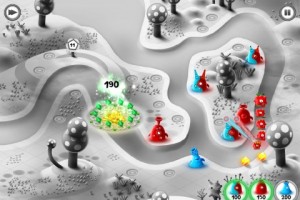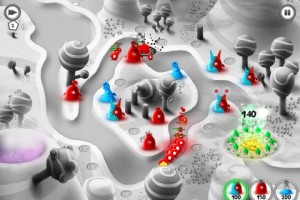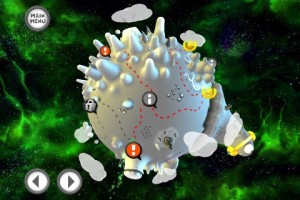Somewhere, deep in the cosmos, live intelligent jelly creatures. They don’t inhabit a planet per se, but rather a living “Diploglobe” — so named, possibly, because it looks like a bloated one-eyed Diplodocus with headphones eternally slapped over its ears. Anyway, the jellies are in a bind because they can’t actually get up and walk; this is bad, because a swift-moving species has invaded the Diploglobe, hoping to harvest the jellies’ precious emeralds. These spineless marauders may think making off with the gems will be a cakewalk, but they’ve got another thing coming — the jellies are well schooled in Tower Defense tactics, and with the player’s help they’re about to launch a potent Jelly Defense (Out Now, $0.99 Release Sale)!
 A great way to approach Jelly Defense is to think of it as the Contre Jour of Tower Defense titles. It’s got an utterly weird and whimsical alien aesthetic, but the player takes this all in stride as fantastic game design and depth yank him or her straight into its world. Genre fans should be well familiar with the basics presented in Jelly Defense’s thorough live tutorial: enemies march along a winding path, susceptible only to certain towers the player can drag and drop onto the curbsides. As enemies fall to a tower’s specialized onslaught, they produce little gold balls the player can spend on building more towers, or upgrading the range and firepower of current emplacements.
A great way to approach Jelly Defense is to think of it as the Contre Jour of Tower Defense titles. It’s got an utterly weird and whimsical alien aesthetic, but the player takes this all in stride as fantastic game design and depth yank him or her straight into its world. Genre fans should be well familiar with the basics presented in Jelly Defense’s thorough live tutorial: enemies march along a winding path, susceptible only to certain towers the player can drag and drop onto the curbsides. As enemies fall to a tower’s specialized onslaught, they produce little gold balls the player can spend on building more towers, or upgrading the range and firepower of current emplacements.
What stands out most to me in Jelly Wars is the fact that tower de-construction becomes just as important in the player’s strategy as setting them up in the first place. Enemy “dropships” waltz into the mouth of each level’s path to spawn hordes of specialized invaders, and these giant dropships are constantly taking turns in an attempt to throw the player off balance — what if a wave of tough red minions is followed by a wave of speedy blue invaders? If the player had a network full of red towers ready to tear up the first onslaught, he or she has to quickly cannibalize those and set up blue towers to fend off the following wave.
Jelly Defense serves up a hard-hitting and satisfying challenge, forcing the player to constantly assess, re-assess, and rearrange the defense strategy on-the-fly. Environments are well constructed to test the player’s logic on how efficient each emplacement is liable to be. A stiff resource management dilemma is likewise on tap: money earned from enemies is weighted toward the beginning of each level, making recycling all the more important as battles wear on. Luckily the player can pump almost as much value out of a tower as he or she has pumped in.
 Just when the player thinks he or she has seen everything Jelly Defense has to offer, some new element pops up to make things more interesting. The giant dropship enemies the player sees only passively at first begin stepping onto the field, effectively acting as bosses; minigames pop up between levels to break up the action a bit; and new tower types can be researched and synthesized in the midst of battle later on. The number of unit types at the player’s disposal is constricted to three for a good portion of the game, but sticking with it definitely rewards in breadth of content.
Just when the player thinks he or she has seen everything Jelly Defense has to offer, some new element pops up to make things more interesting. The giant dropship enemies the player sees only passively at first begin stepping onto the field, effectively acting as bosses; minigames pop up between levels to break up the action a bit; and new tower types can be researched and synthesized in the midst of battle later on. The number of unit types at the player’s disposal is constricted to three for a good portion of the game, but sticking with it definitely rewards in breadth of content.
Jelly Defense’s interface, consisting of drag-and-drop for unit placement and holding on units to upgrade or cannibalize them, feels wonderfully slick. That said, a few tower emplacement spots have ended up too near the screen edges on the iPhone and iPod Touch, making them nigh inaccessible as the player’s finger slides off the screen before reaching them. This isn’t a strategy-breaking problem thanks to its rarity, but it does become a noticeable nuisance on occasion. Also, Jelly Defense shares Zen Wars’ initial habit of making levels stretch ten to twenty minutes once the campaign gets rolling. This is great for hardcore strategy fans who want to tear into a really meaty campaign, but not so much for those who prefer to play their games in short spurts.
 Jelly Defense’s presentation is interesting not only for how beautiful it is, but for how it organically integrates with gameplay. Towers spend a few seconds sprouting from the ground like swiftly growing plants before they can begin targeting enemies, which becomes an important strategic consideration. The upbeat, extraterrestrial-sounding pop music played during the first phase of a level hushes into something more ominous to remind the player that boss encounters are to be taken absolutely seriously. In fact, I can’t get enough of the soundtrack — I haven’t heard alien lyrics this toe-tappingly catchy since I last listened to one of my Cirque du Soleil soundtracks. Here’s to hoping Infinite Dreams releases the soundtrack sometime, so I can stop putting the game on pause just to listen to it!
Jelly Defense’s presentation is interesting not only for how beautiful it is, but for how it organically integrates with gameplay. Towers spend a few seconds sprouting from the ground like swiftly growing plants before they can begin targeting enemies, which becomes an important strategic consideration. The upbeat, extraterrestrial-sounding pop music played during the first phase of a level hushes into something more ominous to remind the player that boss encounters are to be taken absolutely seriously. In fact, I can’t get enough of the soundtrack — I haven’t heard alien lyrics this toe-tappingly catchy since I last listened to one of my Cirque du Soleil soundtracks. Here’s to hoping Infinite Dreams releases the soundtrack sometime, so I can stop putting the game on pause just to listen to it!
If you see this after the sale ends and the $3.99 price tag’s got you down, rest assured that there’s a six to eight hour single-player campaign here, depending on how many times you re-visit levels to master them.
iFanzine Verdict: We’d rather play this game than eat Jell-O — and that’s not a statement we make lightly! If you’re a fan of Tower Defense, Castle Defense, or Real-Time Strategy games in general, Jelly Defense is a clear must-have. Even if you don’t consider yourself a genre fan but have a strong appreciation for challenges of logic, this is one worth taking a chance on if you’ve got the bucks and the time to invest in it.


